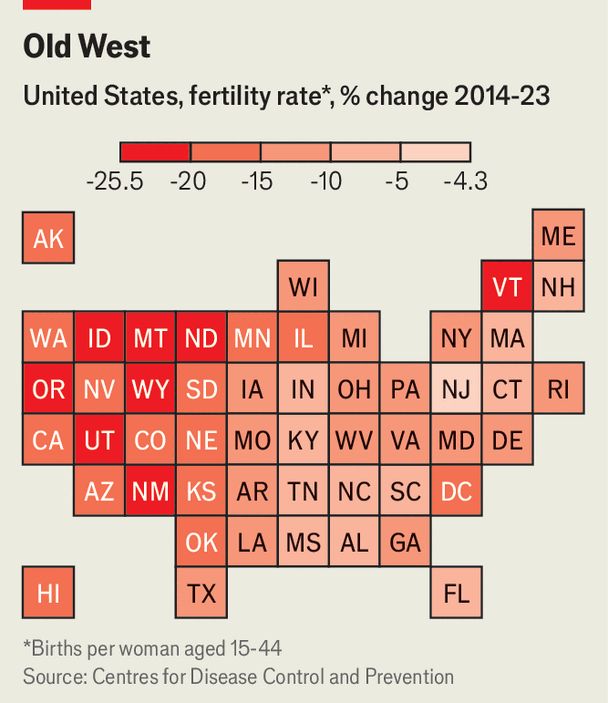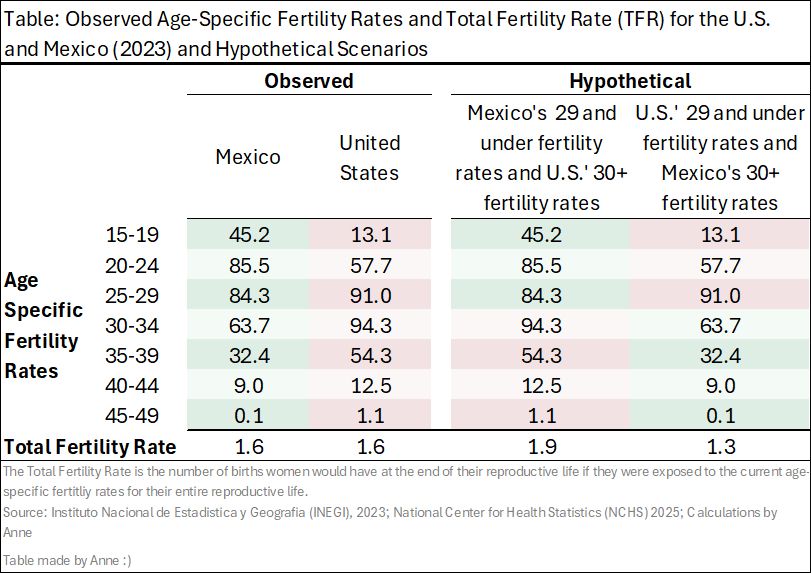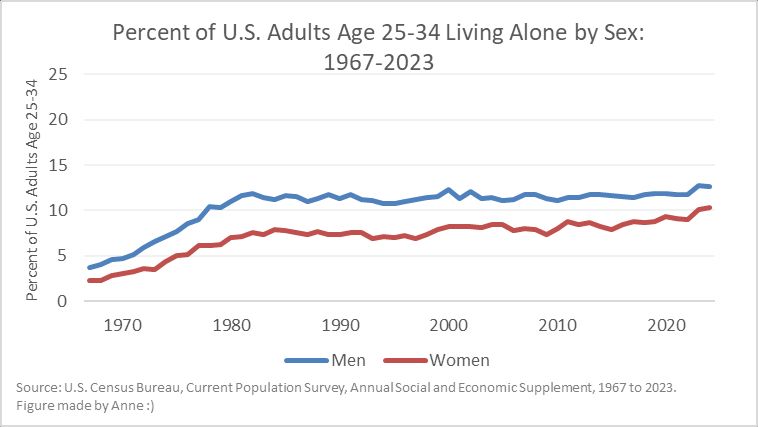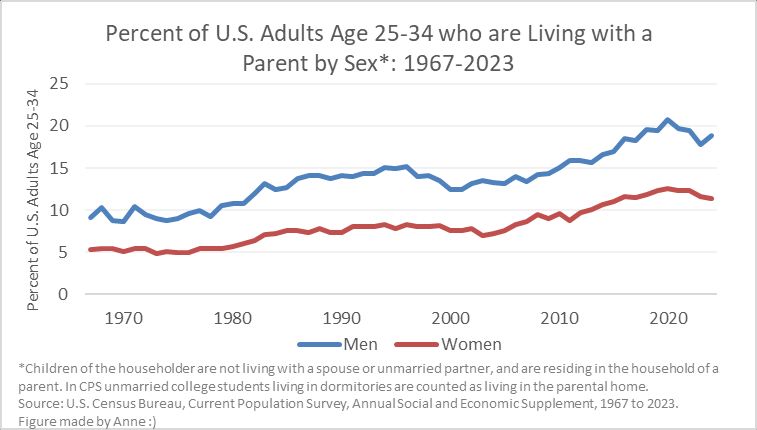
Map of female literacy rates and fertility in Nepal:
The Sudur Paschim province of Nepal has a female literacy rate of 57%, and a total fertility rate of 1.88 🇳🇵
nepalitimes.com/here-now/nep...
@anne-morse-huerc.bsky.social
Fertility nerd. I share fun facts while my data is running | PhD in Demography and Sociology from Penn State | Also a UC Berkeley alum. All views are my own. annermorse.wixsite.com/demography

Map of female literacy rates and fertility in Nepal:
The Sudur Paschim province of Nepal has a female literacy rate of 57%, and a total fertility rate of 1.88 🇳🇵
nepalitimes.com/here-now/nep...

"In recent years, birth rates have dropped only slightly in places where they have long been low...States that had above average fertility rates in 2014 are responsible for more than 80% of the collapse in American birth rates over the past decade."
www.economist.com/finance-and-...

The article that produced the projections:
link.springer.com/article/10.1...

4) The error ranges are pretty tight for the immediate future, because the fertility rates for women in their 40's contribute minimally. So while you have to wait until a cohort reaches 45 to get a final number, you can get a good sense by the time a cohort reaches their late 30s
09.08.2025 19:12 — 👍 0 🔁 0 💬 1 📌 0
3) Completed cohort fertility is only projected to reach below 2 kids per women for the cohorts of women born in 1988 and later.
09.08.2025 19:12 — 👍 0 🔁 0 💬 1 📌 0
2) Completed cohort fertility for the women who turned 45 in 2020 is above replacement.
09.08.2025 19:12 — 👍 0 🔁 0 💬 1 📌 0
Observed and projected completed cohort fertility in the U.S.
Several interesting things to note!🧵
1) Completed cohort fertility INCREASED for the cohort born between 1960 and 1975
Their full paper has a decomposition analysis which asks "are these changes due to changes in the demographic makeup of the population? Or something else?" They found that it's "something else".
07.08.2025 12:44 — 👍 0 🔁 0 💬 0 📌 0
Their full paper also has a regression analysis which found that the effect of being male switched directions between 2005 and 2023; males are now less likely than females to have experienced all markers of adulthood.
Housing burden costs was also significant
www.census.gov/library/work...

New work on young adults reaching adult milestones (living away from parents, in labor force, ever married, has kids.)
They found that 48% of young adults had achieved all 4 milestones in 1975, but this declined to 21% by 2024.
www.census.gov/library/stor...

Utah has the highest refined marriage rate* (49) which is over twice the rate of Louisiana (23.7).
*marriages in the past 12 months per 1,000 unmarried women age 15+
www.bgsu.edu/ncfmr/resour...

And for people who REALLY want to go down a nerdy variance-fertility rabbit hole, I recommend: www.sciencedirect.com/science/arti...
30.04.2025 21:13 — 👍 1 🔁 0 💬 0 📌 0If you want a good study on replacement fertility levels needed in POPULATIONS there is this classic article: (which the authors of the new article appropriately cited): link.springer.com/article/10.1...
30.04.2025 21:13 — 👍 0 🔁 0 💬 1 📌 0The fun part of this new study is how it looks at variability and random events: but variability acts very differently on large sample sizes (national populations) than on small ones (a single female)!
30.04.2025 21:13 — 👍 0 🔁 0 💬 1 📌 0
The study looks at the likelihood of extinction of a lineage of SINGLE female, NOT of nation-size populations.
30.04.2025 21:13 — 👍 0 🔁 0 💬 1 📌 0
If you read this Newsweek article, you might incorrectly conclude that a new study found that countries need a total fertility rate (TFR) of 2.7 to avoid extinction.
But I read the study, and that isn't what the study shows 🧵
www.newsweek.com/babies-mothe...
If Mexico’s current low TFR is due to young women who are postponing (not foregoing) births, Mexico's TFR could very plausibly rise in a few years, and their completed cohort fertility could remain pretty stable.
Or not. Time will tell!

I wondered: What would the total fertility rate be with Mexico’s younger-age fertility rates and the U.S.’ older-age fertility rates? (1.9)
What would the total fertility rate be with Mexico’s older-age fertility rates and the U.S.’ younger-age fertility rates? (1.3)

In 2023, the U.S. and Mexico both had a Total Fertility Rate of 1.6, but the two countries have different age-profiles of childbearing.
Mexico has higher fertility at younger ages.
The U.S. has higher fertility at older ages:


Trends in the percentage of U.S. adults age 25-34 living with nonrelatives, or with “other relatives”:
22.04.2025 13:10 — 👍 0 🔁 0 💬 0 📌 0

Trends in the percentage of U.S. adults age 25-34 living alone and living with a parent:
22.04.2025 13:10 — 👍 0 🔁 0 💬 1 📌 0
A slight tick downward in the % of U.S. adults age 25-34 living with unmarried partners (after a long, steady increase):
22.04.2025 13:10 — 👍 0 🔁 0 💬 1 📌 0
No decline in the % of people ages 25-34 living with a spouse in recent years: 👩🏽🤝👨🏾🏠
Other interesting results if you scroll through:
Women are more likely to live with a spouse or “other relative.”
Men are more likely to live with a parent, alone, or with non-relatives.
Users of the Demographic and Health Surveys, please let your voice be heard!
21.04.2025 19:04 — 👍 1 🔁 0 💬 0 📌 0
Charles Westoff writing 42 years ago (!) on fertility decline in the West:
jstor.org/stable/1972897…

I finally made it over to Bluesky! I'm here to keep sharing fun fertility facts.
To start, a hot-of-the presses report shows increases in first-time parents using paid parental leave in the U.S.--especially for men: 📈👶
www2.census.gov/library/publ...

The world at 8 billion, by yours truly.🌎
www.census.gov/library/stor...